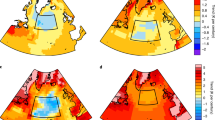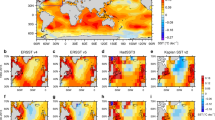Abstract
In the mid-1990s the North Atlantic subpolar gyre warmed rapidly1, which had important climate impacts such as increased hurricane numbers2 and changes to rainfall over Africa, Europe and North America3,4. Evidence suggests that the warming was largely due to a strengthening of the ocean circulation, particularly the Atlantic Meridional Overturning Circulation1,5,6,7. Since the mid-1990s direct and indirect measurements have suggested a decline in the strength of the ocean circulation8,9, which is expected to lead to a reduction in northward heat transport10,11. Here we show that since 2005 a large volume of the upper North Atlantic Ocean has cooled significantly by approximately 0.45 °C or 1.5 × 1022 J, reversing the previous warming trend. By analysing observations and a state-of-the-art climate model, we show that this cooling is consistent with a reduction in the strength of the ocean circulation and heat transport, linked to record low densities in the deep Labrador Sea9. The low density in the deep Labrador Sea is primarily due to deep ocean warming since 1995, but a long-term freshening also played a role. The observed upper ocean cooling since 2005 is not consistent with the hypothesis that anthropogenic aerosols directly drive Atlantic temperatures12.
This is a preview of subscription content, access via your institution
Access options
Subscribe to this journal
Receive 12 print issues and online access
$259.00 per year
only $21.58 per issue
Buy this article
- Purchase on Springer Link
- Instant access to full article PDF
Prices may be subject to local taxes which are calculated during checkout



Similar content being viewed by others
References
Robson, J., Sutton, R., Lohmann, K., Smith, D. & Palmer, M. Causes of the rapid warming of the North Atlantic Ocean in the mid 1990s. J. Clim. 25, 4116–4134 (2012).
Smith, D. M. et al. Skilful multi-year predictions of Atlantic hurricane frequency. Nature Geosci. 3, 846–849 (2010).
Zhang, R. & Delworth, T. Impact of Atlantic multidecadal oscillations on India/Sahel rainfall and Atlantic hurricanes. Geophys. Res. Lett. 33, L17712 (2006).
Sutton, R. T. & Dong, B. Atlantic Ocean influence on a shift in European climate in the 1990s. Nature Geosci. 5, 788–792 (2012).
Yeager, S., Karspeck, A., Danabasoglu, G., Tribbia, J. & Teng, H. A decadal prediction case study: late twentieth-century North Atlantic Ocean heat content. J. Clim. 25, 5173–5189 (2012).
Robson, J. I., Sutton, R. T. & Smith, D. M. Initialized predictions of the rapid warming of the North Atlantic Ocean in the mid 1990s. Geophys. Res. Lett. 25, L19713 (2012).
Yeager, S. & Danabasoglu, G. The origins of late-twentieth-century variations in the large-scale North Atlantic circulation. J. Clim. 27, 3222–3247 (2014).
Smeed, D. et al. Observed decline of the Atlantic Meridional Overturning Circulation 2004 to 2012. Ocean Sci. Discus. 10, 1619–1645 (2013).
Robson, J., Hodson, D., Hawkins, E. & Sutton, R. Atlantic overturning in decline? Nature Geosci. 7, 2–3 (2014).
Dong, B. & Sutton, R. T. Mechanism of interdecadal thermohaline circulation variability in a coupled ocean-atmosphere GCM. J. Clim. 18, 1117–1135 (2005).
Hermanson, L. et al. Forecast cooling of the Atlantic subpolar gyre and associated impacts. Geophys. Res. Lett. 41, 5167–5174 (2014).
Booth, B., Dunstone, N., Halloran, P., Andrews, T. & Bellouin, N. Aerosols implicated as a prime driver of twentieth-century North Atlantic climate variability. Nature 484, 228–232 (2012).
Hodson, D. L. & Sutton, R. T. The impact of resolution on the adjustment and decadal variability of the Atlantic Meridional Overturning Circulation in a coupled climate model. Clim. Dynam. 39, 3057–3073 (2012).
McCarthy, G. D., Haigh, I. D., Hirschi, J. J.-M., Grist, J. P. & Smeed, D. A. Ocean impact on decadal Atlantic climate variability revealed by sea-level observations. Nature 521, 508–510 (2015).
Clement, A. et al. The Atlantic Multidecadal Oscillation without a role for ocean circulation. Science 350, 320–324 (2015).
Kloewer, M., Latif, M., Ding, H., Greatbatch, R. J. & Park, W. Atlantic Meridional Overturning Circulation and the prediction of North Atlantic sea surface temperature. Earth Planet. Sci. Lett. 406, 1–6 (2014).
Hurrell, J. W. Decadal trends in the North Atlantic Oscillation: regional temperatures and precipitation. Science 269, 676–679 (1995).
Zhang, R. & Vallis, G. The role of bottom vortex stretching on the path of the North Atlantic western boundary current and on the northern recirculation gyre. J. Phys. Oceanogr. 37, 2053–2080 (2007).
Roberts, C. D., Garry, F. K. & Jackson, L. C. A multimodel study of sea surface temperature and subsurface density fingerprints of the Atlantic Meridional Overturning Circulation. J. Clim. 26, 9155–9174 (2013).
Johns, W. et al. Continuous, array-based estimates of Atlantic Ocean heat transport at 26.5° N. J. Clim. 24, 2429–2449 (2011).
Visbeck, M. et al. in The North Atlantic Oscillation: Cinematic Significance and Environmental Impact (eds Hurrell, J. W. et al.) 113–146 (American Geophysical Union, 2003).
Menary, M. B., Hodson, D. L., Robson, J. I., Sutton, R. T. & Wood, R. A. A mechanism of internal decadal Atlantic Ocean variability in a high-resolution coupled climate model. J. Clim. 28, 7764–7785 (2015).
Lozier, M. S., Roussenov, V., Reed, M. S. & Williams, R. G. Opposing decadal changes for the North Atlantic Meridional Overturning Circulation. Nature Geosci. 3, 728–734 (2010).
Hátún, H., Sandø, A. B., Drange, H., Hansen, B. & Valdimarsson, H. Influence of the Atlantic subpolar gyre on the thermohaline circulation. Science 309, 1841–1844 (2005).
Barrier, N., Cassou, C., Deshayes, J. & Treguier, A.-M. Response of North Atlantic Ocean circulation to atmospheric weather regimes. J. Phys. Oceanogr. 44, 179–201 (2014).
Gettelman, A., Shindell, D. & Lamarque, J. Impact of aerosol radiative effects on 2000–2010 surface temperatures. Clim. Dynam. 45, 2165–2179 (2015).
Pinto, J. G. & Raible, C. C. Past and recent changes in the North Atlantic Oscillation. WIREs Clim. Change 3, 79–90 (2012).
Rahmstorf, S. et al. Exceptional twentieth-century slowdown in Atlantic Ocean overturning circulation. Nature Clim. Change 5, 475–480 (2015).
Curry, R. & Mauritzen, C. Dilution of the northern North Atlantic Ocean in recent decades. Science 308, 1772–1774 (2005).
McGregor, S. et al. Recent Walker Circulation strengthening and Pacific cooling amplified by Atlantic warming. Nature Clim. Change 4, 888–892 (2014).
Good, S. A., Martin, M. J. & Rayner, N. A. EN4: Quality controlled ocean temperature and salinity profiles and monthly objective analyses with uncertainty estimates. J. Geophys. Res. 118, 6704–6716 (2013).
Rayner, N. et al. Global analyses of sea surface temperature, sea ice, and night marine air temperature since the late nineteenth century. J. Geophys. Res. 108, 4407 (2003).
Kalnay, E. et al. The NCEP/NCAR 40-year reanalysis project. Bull. Am. Meteorol. Soc. 77, 437–471 (1996).
Josey, S., Gulev, S. & Yu, L. in Ocean Circulation and Climate: A 21st Century Perspective (eds Sidler, G., Griffies, S., Gould, J. & Church, J.) 115–136 (Academic, 2013).
Williams, K. et al. The Met Office Global Coupled model 2.0 (GC2) configuration. Geosci. Model Dev. Discus. 8, 521–565 (2015).
Baehr, J., Hirschi, J., Beismann, J. & Marotzke, J. Monitoring the meridional overturning circulation in the North Atlantic: a model-based array design study. J. Mar. Res. 62, 283–312 (2004).
Acknowledgements
We thank the UK Met Office, and particularly M. Andrews, for providing the model data used in this study. J.R. was supported by the Seasonal-to-Decadal Climate Prediction for the Improvement of European Climate Service project (SPECS, GA 308378) and J.R. and P.O. were supported by the Dynamics and Predictability of the Atlantic Meridional Overturning and Climate project (DYNAMOC, NE/M005127/1). R.S. was supported by NERC via the National Centre for Atmospheric Science (NCAS), including the ACSIS project.
Author information
Authors and Affiliations
Contributions
J.R. and R.S. jointly conceived the study. J.R. and P.O. analysed the observational and model data. J.R. led the writing of the manuscript with contributions and input from all authors.
Corresponding author
Ethics declarations
Competing interests
The authors declare no competing financial interests.
Supplementary information
Supplementary Information
Supplementary Information (PDF 3329 kb)
Rights and permissions
About this article
Cite this article
Robson, J., Ortega, P. & Sutton, R. A reversal of climatic trends in the North Atlantic since 2005. Nature Geosci 9, 513–517 (2016). https://doi.org/10.1038/ngeo2727
Received:
Accepted:
Published:
Issue Date:
DOI: https://doi.org/10.1038/ngeo2727
This article is cited by
-
Decrease of the spatial variability and local dimension of the Euro-Atlantic eddy-driven jet stream with global warming
Climate Dynamics (2024)
-
Ocean heat uptake and interbasin redistribution driven by anthropogenic aerosols and greenhouse gases
Nature Geoscience (2023)
-
Winter heavy precipitation events over Northern Europe modulated by a weaker NAO variability by the end of the 21st century
npj Climate and Atmospheric Science (2023)
-
Changing environmental conditions have altered the feeding ecology of two keystone Arctic marine predators
Scientific Reports (2023)
-
Cold blobs in the subpolar North Atlantic: seasonality, spatial pattern, and driving mechanisms
Ocean Dynamics (2023)



